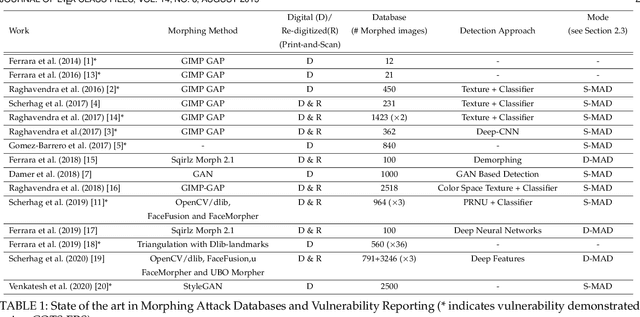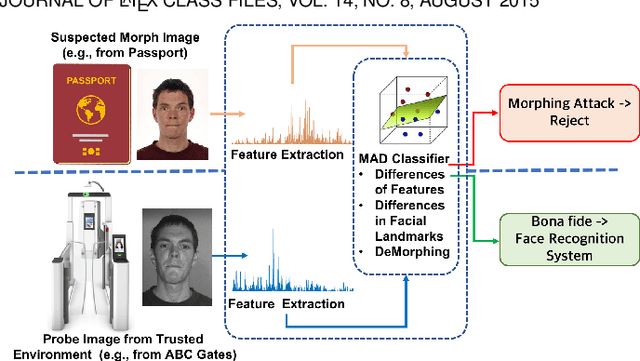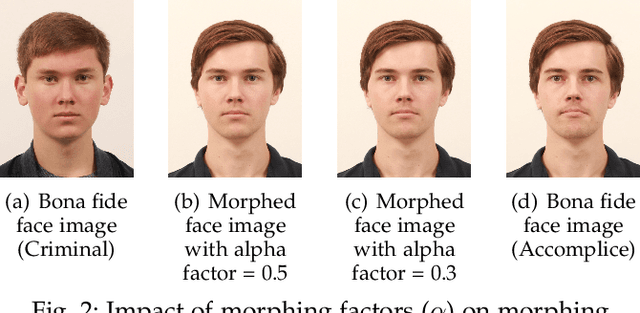Annalisa Franco
ONOT: a High-Quality ICAO-compliant Synthetic Mugshot Dataset
Apr 17, 2024Abstract:Nowadays, state-of-the-art AI-based generative models represent a viable solution to overcome privacy issues and biases in the collection of datasets containing personal information, such as faces. Following this intuition, in this paper we introduce ONOT, a synthetic dataset specifically focused on the generation of high-quality faces in adherence to the requirements of the ISO/IEC 39794-5 standards that, following the guidelines of the International Civil Aviation Organization (ICAO), defines the interchange formats of face images in electronic Machine-Readable Travel Documents (eMRTD). The strictly controlled and varied mugshot images included in ONOT are useful in research fields related to the analysis of face images in eMRTD, such as Morphing Attack Detection and Face Quality Assessment. The dataset is publicly released, in combination with the generation procedure details in order to improve the reproducibility and enable future extensions.
Dealing with Subject Similarity in Differential Morphing Attack Detection
Apr 11, 2024Abstract:The advent of morphing attacks has posed significant security concerns for automated Face Recognition systems, raising the pressing need for robust and effective Morphing Attack Detection (MAD) methods able to effectively address this issue. In this paper, we focus on Differential MAD (D-MAD), where a trusted live capture, usually representing the criminal, is compared with the document image to classify it as morphed or bona fide. We show these approaches based on identity features are effective when the morphed image and the live one are sufficiently diverse; unfortunately, the effectiveness is significantly reduced when the same approaches are applied to look-alike subjects or in all those cases when the similarity between the two compared images is high (e.g. comparison between the morphed image and the accomplice). Therefore, in this paper, we propose ACIdA, a modular D-MAD system, consisting of a module for the attempt type classification, and two modules for the identity and artifacts analysis on input images. Successfully addressing this task would allow broadening the D-MAD applications including, for instance, the document enrollment stage, which currently relies entirely on human evaluation, thus limiting the possibility of releasing ID documents with manipulated images, as well as the automated gates to detect both accomplices and criminals. An extensive cross-dataset experimental evaluation conducted on the introduced scenario shows that ACIdA achieves state-of-the-art results, outperforming literature competitors, while maintaining good performance in traditional D-MAD benchmarks.
V-MAD: Video-based Morphing Attack Detection in Operational Scenarios
Apr 10, 2024Abstract:In response to the rising threat of the face morphing attack, this paper introduces and explores the potential of Video-based Morphing Attack Detection (V-MAD) systems in real-world operational scenarios. While current morphing attack detection methods primarily focus on a single or a pair of images, V-MAD is based on video sequences, exploiting the video streams often acquired by face verification tools available, for instance, at airport gates. Through this study, we show for the first time the advantages that the availability of multiple probe frames can bring to the morphing attack detection task, especially in scenarios where the quality of probe images is varied and might be affected, for instance, by pose or illumination variations. Experimental results on a real operational database demonstrate that video sequences represent valuable information for increasing the robustness and performance of morphing attack detection systems.
Detecting Morphing Attacks via Continual Incremental Training
Jul 27, 2023



Abstract:Scenarios in which restrictions in data transfer and storage limit the possibility to compose a single dataset -- also exploiting different data sources -- to perform a batch-based training procedure, make the development of robust models particularly challenging. We hypothesize that the recent Continual Learning (CL) paradigm may represent an effective solution to enable incremental training, even through multiple sites. Indeed, a basic assumption of CL is that once a model has been trained, old data can no longer be used in successive training iterations and in principle can be deleted. Therefore, in this paper, we investigate the performance of different Continual Learning methods in this scenario, simulating a learning model that is updated every time a new chunk of data, even of variable size, is available. Experimental results reveal that a particular CL method, namely Learning without Forgetting (LwF), is one of the best-performing algorithms. Then, we investigate its usage and parametrization in Morphing Attack Detection and Object Classification tasks, specifically with respect to the amount of new training data that became available.
Morphing Attack Potential
Apr 28, 2022



Abstract:In security systems the risk assessment in the sense of common criteria testing is a very relevant topic; this requires quantifying the attack potential in terms of the expertise of the attacker, his knowledge about the target and access to equipment. Contrary to those attacks, the recently revealed morphing attacks against Face Recognition Systems (FRSs) can not be assessed by any of the above criteria. But not all morphing techniques pose the same risk for an operational face recognition system. This paper introduces with the Morphing Attack Potential (MAP) a consistent methodology, that can quantify the risk, which a certain morphing attack creates.
Morphing Attack Detection -- Database, Evaluation Platform and Benchmarking
Jun 16, 2020



Abstract:Morphing attacks have posed a severe threat to Face Recognition System (FRS). Despite the number of advancements reported in recent works, we note serious open issues that are not addressed. Morphing Attack Detection (MAD) algorithms often are prone to generalization challenges as they are database dependent. The existing databases, mostly of semi-public nature, lack in diversity in terms of ethnicity, various morphing process and post-processing pipelines. Further, they do not reflect a realistic operational scenario for Automated Border Control (ABC) and do not provide a basis to test MAD on unseen data, in order to benchmark the robustness of algorithms. In this work, we present a new sequestered dataset for facilitating the advancements of MAD where the algorithms can be tested on unseen data in an effort to better generalize. The newly constructed dataset consists of facial images from 150 subjects from various ethnicities, age-groups and both genders. In order to challenge the existing MAD algorithms, the morphed images are with careful subject pre-selection created from the subjects, and further post-processed to remove the morphing artifacts. The images are also printed and scanned to remove all digital cues and to simulate a realistic challenge for MAD algorithms. Further, we present a new online evaluation platform to test algorithms on sequestered data. With the platform we can benchmark the morph detection performance and study the generalization ability. This work also presents a detailed analysis on various subsets of sequestered data and outlines open challenges for future directions in MAD research.
Template co-updating in multi-modal human activity recognition systems
Dec 04, 2019



Abstract:Multi-modal systems are quite common in the context of human activity recognition; widely used RGB-D sensors (Kinect is the most prominent example) give access to parallel data streams, typically RGB images, depth data, skeleton information. The richness of multimodal information has been largely exploited in many works in the literature, while an analysis of their effectiveness for incremental template updating has not been investigated so far. This paper is aimed at defining a general framework for unsupervised template updating in multi-modal systems, where the different data sources can provide complementary information, increasing the effectiveness of the updating procedure and reducing at the same time the probability of incorrect template modifications.
Face morphing detection in the presence of printing/scanning and heterogeneous image sources
Jan 25, 2019



Abstract:Face morphing represents nowadays a big security threat in the context of electronic identity documents as well as an interesting challenge for researchers in the field of face recognition. Despite of the good performance obtained by state-of-the-art approaches on digital images, no satisfactory solutions have been identified so far to deal with cross-database testing and printed-scanned images (typically used in many countries for document issuing). In this work, novel approaches are proposed to train Deep Neural Networks for morphing detection: in particular generation of simulated printed-scanned images together with other data augmentation strategies and pre-training on large face recognition datasets, allowed to reach state-of-the-art accuracy on challenging datasets from heterogeneous image sources.
 Add to Chrome
Add to Chrome Add to Firefox
Add to Firefox Add to Edge
Add to Edge